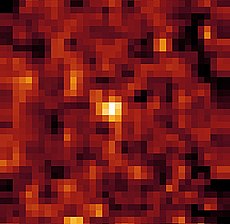(55565) 2002 AW197

|
|
| Discovery | |
|---|---|
| Discovered by |
Michael E. Brown Chad Trujillo Eleanor F. Helin Michael Hicks Kenneth J. Lawrence Steven H. Pravdo Palomar Observatory (675) |
| Discovery date | 10 January 2002 |
| Designations | |
| MPC designation | (55565) 2002 AW197 |
| none | |
|
Cubewano (MPC) Extended (DES) |
|
| Orbital characteristics | |
| Epoch 13 January 2016 (JD 2457400.5) | |
| Uncertainty parameter 3 | |
| Observation arc | 6647 days (18.20 yr) |
| Aphelion | 53.771 AU (8.0440 Tm) |
| Perihelion | 41.282 AU (6.1757 Tm) |
| 47.526 AU (7.1098 Tm) | |
| Eccentricity | 0.13139 |
| 327.65 yr (119674 d) | |
|
Average orbital speed
|
4.31 km/s |
| 293.876° | |
| 0° 0m 10.83s / day | |
| Inclination | 24.351° |
| 297.438° | |
| 293.300° | |
| Earth MOID | 40.3467 AU (6.03578 Tm) |
| Jupiter MOID | 36.369 AU (5.4407 Tm) |
| Physical characteristics | |
| Dimensions |
768+39 −108 km 700±50 km |
| 8.86 h (0.369 d) | |
|
Sidereal rotation period
|
8.86 h |
|
0.117+0.04 −0.03 0.17±0.03 |
|
| Temperature | ≈ 39–40 K |
| (moderately red) B−V=0.91, V−R=0.56 |
|
| 20.0 (opposition) | |
| 3.5 | |
768+39
−38 km
(55565) 2002 AW197 is a classical Kuiper belt object (cubewano). Measurements with the Spitzer Space Telescope have confirmed 2002 AW197 as a probable dwarf planet, although it has not been officially classified as such by the IAU. Light-curve-amplitude analysis shows only small deviations, which suggests that 2002 AW197 is a spheroid with small albedo spots.Tancredi (2010) accepts it as a dwarf planet. Mike Brown's website lists it as a highly likely dwarf planet.
It was discovered on January 10, 2002, by Michael Brown et al. It is located near the Kuiper cliff.
Observations of thermal emissions by the Spitzer Space Telescope in 2007 give a diameter of 734+116
−108 km and an albedo of 0.117+0.04
−0.03. The newest estimate is 768+39
−38 km
ESO analysis of spectra reveals a strong red slope and no presence of water ice (in contrast to Quaoar, also red) suggesting organic material (see comparison of colours and typical composition inferred from spectra of the TNOs).
...
Wikipedia
